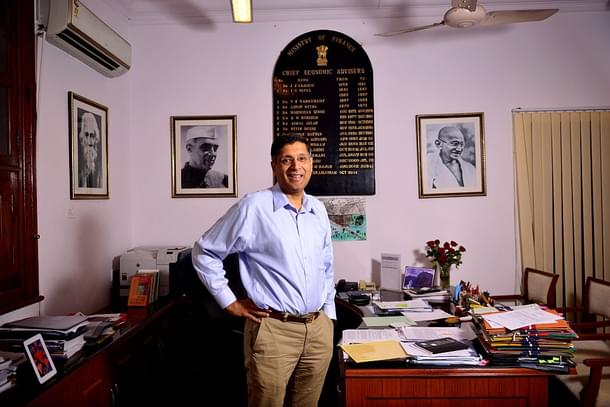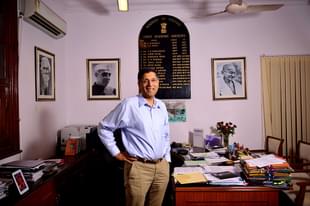Economy
The Four Economic Surveys Of Arvind Subramanian: 2015-2018
Subhomoy Bhattacharjee
Jan 30, 2018, 04:04 PM | Updated 04:04 PM IST
Save & read from anywhere!
Bookmark stories for easy access on any device or the Swarajya app.


How is the tone of possibly the last Economic Survey by Chief Economic Adviser (CEA) Arvind Subramanian? This has been the fourth Survey he has authored in this government. It is instructive to compare the four to discern how they measure up in terms of the agenda they set and the willingness to examine themselves subsequently. Of course, it is unfair to assume that the twists and turns of the Indian economy have much to do with the Survey, but as the volume gets so much importance just before the budget is tabled, it is fair to compare it with the actual developments.
And while the length of his term is far shorter than that of Shankar Acharya (eight years), Bimal Jalan (seven) and Ashok Lahiri (five), it has been a long innings, no doubt, where the author has had enough time to turn back to examine if his prescriptions were indeed right for the economy. There was one Survey, that of 2013-14, Finance Minister Arun Jaitley presented before Subramanian came in, but that, to put it mildly, lacked authorship. It was signed by Finance Secretary Arvind Mayaram and was clearly a job put together.
Reading the four together is also a pointer to the economic advice Prime Minister Narendra Modi received, and provides an indication of where he diverged from those.
One senses that Subramanian was also aware of the need for this analysis. “The twilight of the government’s current term is an appropriate juncture to step back and draw broader lessons for the Indian economy going forward,” the first few paragraphs of Economic Survey 2017-18 notes. He also makes a candid admission that “recent macroeconomic developments are a reminder that the battle for macro-economic stability is never won, that even major victories (such as those post-2014) are always provisional, and that vigilance is always needed”.
The CEA was euphoric when he wrote the first chapters of the Economic Survey 2014-15, his maiden effort. “As the new government presents its first full-year budget, a momentous opportunity awaits. India has reached a sweet spot—rare in the history of nations—in which it could finally be launched on a double-digit (italics mine) medium-term growth trajectory.” The soaring tone continued through most of the operative segments. Borrowing Prime Minister Narendra Modi’s call of “wiping every tear from every eye”, Subramanian made a prescient remark: “The power of growth to lift all boats will depend critically on its employment creation potential.”
He devoted considerable space to dwell on employment elasticity of the economy to parse through the evidence and an equally large space for calculating the inflation trends based on how international crude prices move. It is not deja vu, but it is also not a coincidence that he returns to these themes again, four years later.
With that he also introduced the now-famous term “JAM trinity” – the happy combination of Jan Dhan, Aadhaar and Mobiles as a tool that he said could wipe tear from every eye. Note that pushing Jan Dhan as a mission mode programme by Modi predates the Survey and the subsequent budget.
Within a year the tone became far more sombre. Economic Survey 2015-16 clearly asked for “recalibration of expectations”. It is interesting that the Survey chafed against the perception that the government was not doing enough on “Big Bang reforms because of the dispersed nature of power in India and the absence of that impelling driver—crisis”. Demonetisation was some months down the road.
The CEA used a lot of space in the volume to battle against this emerging perception that governance had stalled. “Perhaps the underlying anxiety is that the Indian economy is not realizing its full potential. It is incontrovertible that India is still oozing potential”. He suggested that the economic managers of North Block should build on creating fiscal space to allow private investment to bloom and craft a policy to allow companies to go into insolvency. The “Chakravyuha challenge for the Indian economy”, as he put it. Capital comes in, but cannot be pulled out of a failed enterprise. It argued therefore in favour of a “persistent, creative and encompassing incrementalism” to make India return to a higher growth path.
There was only one way to describe what commentators wanted to read in the Economic Survey 2016-17. Subramanian knew it. He made a most unusual beginning to the Survey. He prefaced a chapter to the volume, calling it “Eight Interesting Facts about India”. They were backed with research, something that people had come to associate with his Surveys. They were based on careful study of big data. They were all meant to draw some attention away from what was going to be the government’s first assessment of demonetisation. It came just three months after the announcement. Whatever space was left was going to be captured by the next Big Bang measure – the goods and services tax or GST.
He again referred to the sweet spot. “In the aftermath of demonetisation, and because cyclical developments will make economic management harder, articulating and embracing those shifts will be critical to ensuring that that sweet spot is enduring not evanescent”. The tone changed to demand alerting the incremental approach. “There may be valid reasons for the status quo but overall they indicate that the embrace of markets—even in the modest sense of avoiding intrusive intervention, protecting property rights, disposing of unviable public sector assets and exiting from areas of comparative non advantage, and allowing economic agents to face market prices—remains a work-in-progress”.
The CEA had read the portents well. Air India disinvestment, bank recapitalisation and tightening of the Insolvency and Bankruptcy Act to make life difficult for promoters, were in the works in the year ahead.




